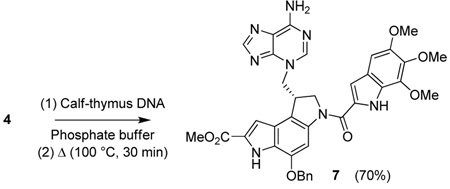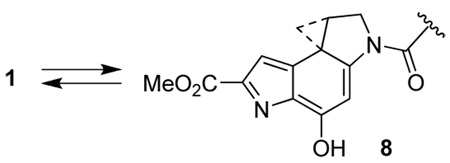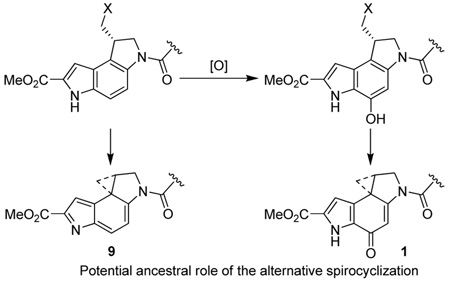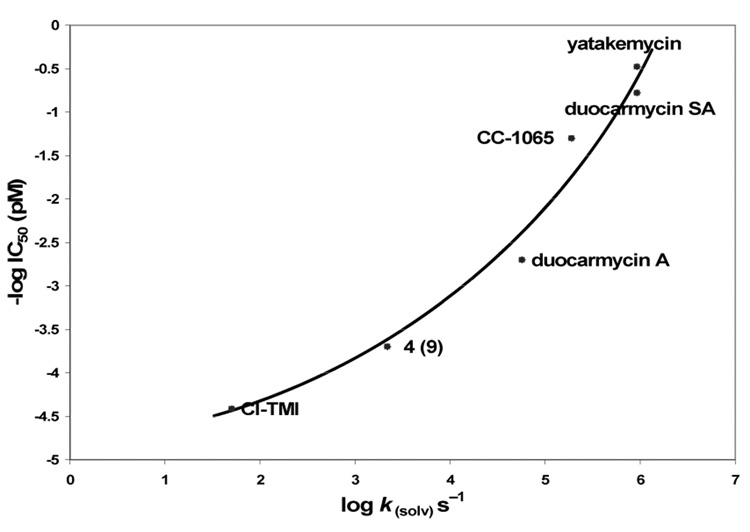Abstract
A unique alternative to the p-spirocyclization for activation of compounds containing the duocarmycin SA alkylation subunit was established involving indole NH deprotonation and subsequent cyclopropane formation. The structural characterization of an alternative spirocyclization product, and the establishment of its relative reactivity, intrinsic reaction regioselectivity, biological activity, and DNA alkylation properties (selectivity, rate, and efficiency) including the isolation, characterization, and quantitation of its adenine N3 adduct, are disclosed.
Duocarmycin SA (1)1 and yatakemycin (2)2 are the most potent members of a small class of naturally occurring antitumor agents that also include CC-1065 and duocarmycin A (Figure 1A).3 Each derives its biological properties from a characteristic sequence-selective DNA alkylation reaction3–7 entailing a stereoelectronically-controlled adenine N3 addition to the least substituted carbon of the activated cyclopropane. Embedded in their structures is the key cross-conjugated vinylogous amide stabilization of an otherwise reactive cyclopropacyclohexadienone that masks the electrophilic reactivity.8 We have suggested that its disruption by way of a DNA binding induced conformational change in the molecule that twists the linking amide provides the catalysis for the DNA alkylation reaction and accounts for their intrinsic selectivity for their biological target (DNA) alkylation.9 That is, the compounds are unreactive until reaching their biological target and are activated for DNA alkylation by a binding-induced conformational change.
Figure 1.
A) Natural products. B) Alternate spirocyclization pathway.
Herein, we report an alternative spirocyclization for activation of compounds bearing the duocarmycin SA alkylation subunit and discuss the ramifications of its observation. Thus, it is possible that spirocyclization by way of indole NH deprotonation and subsequent cyclopropane formation10 would provide analogous, albeit less stabilized electrophiles (Figure 1B). Deliberate efforts to promote this type of ring closure were undertaken enlisting phenol protected substrates that preclude the conventional p-spirocyclization. Benzyl ether 311 was treated with phosphazene base P4-t-Bu (1-tert-butyl-4,4,4-tris(dimethylamino)-2,2- bis[tris(dimethylamino)-phosphoran-ylidenamino]-2Λ5,4Λ5- catenadi(phosphazene)) in DMF (2 h) to afford the alternatively spirocyclized product 4 (ca. 20%). Upon disappearance of starting material (LC/MS), the products of the reaction were subjected to chromatography, and provided the sensitive product 4. This product proved surprisingly stable to chromatography, extended times in solution, and prolonged storage at room temperature. Nonetheless, this material is much more reactive than duocarmycin SA and the yield of purified 4 reflects this intrinsic reactivity. The use of more conventional strong bases including NaH and DBU in both DMF and CH2Cl2 failed to provide 4 (TLC, LC/MS), whereas substituting MeCN for DMF and increasing the amount of P4-base afforded higher yields of 4. With these adjustments, careful exclusion of water, and an increasing experience with the isolation and chromatographic purification of 4, the spirocyclization was optimized (2 equiv P4-t- Bu, MeCN, 3.5 h) to provide 4 in yields as high as 56% (eq 1). Not surprisingly, P4-base treatment of the free phenol of 3 under similar conditions (1.2 equiv P4-t-Bu, MeCN, 1 h) cleanly provides only duocarmycin SA (1).
 |
(1) |
The 1H NMR of 4 displayed three well-defined cyclopropane CH signals at δ 0.72, 1.70, and 1.82, and diastereotopic signals for C1-H2 exhibiting a large geminal coupling constant of 12 Hz (δ 3.45 and δ 3.96) analogous to those observed with duocarmycin SA (Supporting Information Figure S1). The most diagnostic 1H NMR signals proved to be the disappearance of the indole NH (δ 10.30 in acetone-d6) and a marked shift in the C3-H from δ 8.19 (br s, 1H) in the precursor 3 to δ 4.82 (s, 1H) in 4. This latter remarkable shift in C3-H is indicative of an aromatic CH in 3 and its conversion to a β-CH of an electron-rich olefin (enamide) in 4.
The 13C NMR of 4 also exhibited characteristic distinctions between 4 and the natural product. Although the chemical shift of C-8 in 4 (δ 13.7) is indicative of a cyclopropane, the same carbon in duocarmycin SA is shifted significantly downfield (δ 27.4), reflecting the different electronic environments of the two ring systems. Aside from the C-4 carbonyl carbon of 1 (δ 179.0) that is now an olefinic carbon in the extended π -system of 4 (δ 138.2), the greatest difference in chemical shift is seen with C-2a. This carbon in 1 (δ 163.0) displays the characteristic chemical shift of a β-carbon of an α,β-unsaturated enone system, whereas the same carbon in 4 shifts dramatically upfield to δ92.2, reflecting the conversion to an electron-rich olefin.12
The duocarmycin SA alkylation subunit exhibits no solvolysis reactivity at pH 7 (stable) and its reactivity only becomes measurable at pH 3 (k = 1.09 × 10−6 s−1, t1/2 = 177 h).13 Consistent with observations made during its preparation, 4 proved to be much more reactive (420-fold), exhibiting a short solvolysis half-life at pH 3 (50% MeOH–buffer, buffer = 4:1:20 v/v/v 0.1 M citric acid, 0.2 M Na2HPO4, H2O; k = 4.57 × 10−4 s−1, t1/2 = 25.3 min). Unlike duocarmycin SA for which no solvolysis is observed at pH 7, 4 also underwent rapid solvolysis at pH 7 (50% MeOH–universal buffer, k = 2.66 × 10−4 s−1, t1/2 = 43.4 min). Since 4 exhibited little difference in reactivity at pH 3 and 7, albeit in different buffers, its solvolysis pH rate profile was established under more comparable conditions using a universal buffer (pH 2–7, 0.2 M B(OH)3, 0.05 M citric acid, 0.1 M Na3PO4).14 As the initial observations suggested, the rate of solvolysis proved independent of pH in the range of 3–7 indicating that it constitutes an uncatalyzed (vs acid-catalyzed) reaction in this range (Figure 2). Only at pH 2 did the solvolysis of 4 begin to exhibit an acid dependence. Most importantly, this established 4 as a viable spirocyclization, but one that is less productive than the conventional p-spirocyclization.
Figure 2.
Rates of solvolysis and solvolysis pH rate profile for 4.
Members of this class participate in a characteristic, stereoelectronically-controlled ring opening reaction with predominate nucleophilic addition to the least substituted cyclopropane carbon where both the compound reactivity and the cyclopropane stereoelectronic alignment influence the reaction regioselectivity.3 Addition of MeOH to 4, which did not require added acid catalyst, provided a 1.7:1 mixture of two products of which the major product is derived from attack at the more substituted cyclopropane carbon (eq 2).
 |
(2) |
Like observations made with 1, chiral phase HPLC analysis of the ring expansion product derived from enantiomerically pure 4 alongside racemic material indicated the generation of a single enantiomer for 6, suggesting a SN2 ring expansion with no loss of stereochemical integrity at the reacting center. Thus, 4 exhibits both a reversed and reduced reaction regioselectivity (1:1.7 vs 6.5:1 for 1) and a greatly diminished stability relative to duocarmycin SA.
Consistent with this increased reactivity, the cytotoxic activity of (−)-4 (natural enantiomer configuration; L1210, IC50 = 5 nM) was 500-fold less potent than (+)-1 (IC50 = 10 pM). This corresponds remarkably well with the observation that it is 420- fold less stable than 1, qualitatively and quantitatively following the direct relationship between chemical stability and biological potency established for this class of agents.15 Interestingly, the unnatural enantiomer of 4 (IC50 = 7 nM) is essentially equipotent with the natural enantiomer. Thus, unlike previous trends seen with the enantiomer pairs of duocarmycin SA analogues,9 there is not a significant difference in the cytotoxic potency of (−)- and (+)-4, albeit at this reduced and yet substantial level.
Even more interesting and despite the increased reactivity, the individual enantiomers of 4 still exhibited the same, but distinguishable, DNA alkylation selectivity as their duocarmycin SA counterparts (Supporting Information Figure 3).4 That is, the major alkylation sites for the two enantiomers of 4 proved to be the same sites observed with the respective duocarmycin SA enantiomers. However, and reflective of their reactivity, additional minor adenine alkylation sites not observed with 1 were detected with 4. Under the cell-free conditions of the DNA alkylation studies, the efficiencies of alkylation for the natural enantiomers were not significantly different despite the enhanced reactivity of 4 versus 1, and even their relative rates of alkylation were comparable (4 > 1 by 4-fold). Unlike duocarmycin SA (1) where the unnatural enantiomer alkylates DNA with a considerably slower rate and lower efficiency,4 the unnatural enantiomer of 4 alkylated DNA with an efficiency and rate not readily distinguishable from those of the natural enantiomer (0.5 to 1-fold). Since the conformational changes responsible for catalysis (activation) of the DNA alkylation reaction that lead to the enantiomeric distinctions for 1 are no longer required and are not operative with 4, it is not surprising that the two enantiomers of 4 display comparable biological properties (cytotoxic activity, DNA alkylation relative rates and efficiencies). Finally, unlike the corresponding seco precursor to (+)-duocarmycin SA that exhibits cytotoxic activity and DNA alkylation properties (rel. rate, efficiency, and selectivity) indistinguishable from 1 because of its facile spirocyclization, 3 was found to only provide trace DNA alkylation even with prolonged reaction times (25 °C, 96 h, ca 1% that of 4 at 1 h, 25 °C). The results of these studies reaffirm important features contributing to the DNA alkylation selectivity of 1. The most prominent of these is that the source of catalysis for the DNA alkylation reaction, which is presumably different for 1 versus 4, is not what determines the selectivity, but rather that it is derived from the intrinsic AT-rich noncovalent binding selectivity of 1 (and 4).4,9 Significantly, the comparable behavior of 1 and 4 indicate that a sequence-dependent DNA backbone phosphate protonation6,16 of the C4 carbonyl of 1 (not present with 4) cannot be contributing to its DNA alkylation selectivity.
Completing the characterization of its properties, the thermally released adenine adduct resulting from the DNA alkylation of 4 was isolated, quantitated (70% yield), and structurally characterized (Supporting Information). These studies revealed that the adenine alkylation accounts for 70% of the consumed agent, indicating that it constitutes the major reaction under the conditions of its examination (1:55 agent:base-pair ratio; calf-thymus DNA), and that it occurs with adenine addition to the least substituted cyclopropane carbon indicative of a SN2 alkylation mechanism, eq 3. The remainder of 4 (30%) provided multiple products derived from nucleophilic attack by phosphate, water, EtOH and NaOAc and were isolated (extracted) and quantitated prior to thermal depurination and release of 7. Significantly, no adenine addition product resulting from attack at the more substituted cyclopropane carbon was detected, nor was any minor groove guanine alkylation and depurination detected (LC/MS) under the conditions examined.4 Consequently and like duocarmycin SA itself, the adenine N3 addition accounts for the near exclusive consumption of 4 by DNA in spite of its reactivity. Finally, these studies confirm that it is 4 itself, and not its debenzylation product, that is responsible for the DNA alkylation and the resulting biological activity.
 |
(3) |
Since 8 (C4-OH vs C4-OBn) represents a tautomer of 1, it is possible that it is the reactive tautomer suggesting an internal protonation17 may serve to assist activation of the natural product for DNA alkylation, eq 4.
 |
(4) |
However, given that the pyrrole ring may be replaced with aryl rings that cannot support this alternative spirocyclization and yet they exhibit comparable or even enhanced DNA alkylation properties (e.g. benzene, thiophene),11,18 it is not yet clear what significance this alternative spirocyclization (or tautomer) may hold. Rather than being either incidental to the structure of 1 or integral to the properties of 1 today, it is even possible that the most significant role such a spirocyclization may have played is in Nature’s evolution of this class of DNA alkylating agents. Given the ease of p-spirocyclization and the assumption that it is the last step in the biosynthesis following activation of a primary alcohol for displacement, it is tempting to suggest that such compounds first emerged without the ability to undergo the p-spirocyclization (precursors lacking the phenol), eq 5. Given their activity (L1210 IC50 = 5 nM) and the growth advantage such an ancestor might have provided the producing bacteria, evolutionary pressures may have improved on this by aryl hydroxylation to afford the present day phenol precursors to the p-spirocyclization providing the exceptionally potent derivatives (e.g. 1, IC50 = 10 pM). This would suggest that such compounds may not only be ancestral precursors to 1, but that they may constitute natural products yet to be identified.
 |
(5) |
A provocative indication that there is perhaps merit to this proposal emerges from the examination of the correlation between biological potency (cytotoxic activity, −log IC50) and chemical stability (log ksolv) where 9, like 4, would be projected to lie at an early stage of Nature’s steps in the optimization of this class of DNA alkylating agents, Figure 3.
Figure 3.
Plot of −log IC50 (L1210, cytotoxic activity) versus log ksolv (pH 3) that includes the natural products and a representative related compound illustrating the direct correlation between stability and biological potency and highlighting Nature’s potential steps in the optimization of this class of DNA alkylating agents.
Supplementary Material
Full experimentals are provided. This material is available free of charge via the Internet at http://pubs.acs.org.
Acknowledgments
We gratefully acknowledge the financial support of the National Institutes of Health (CA41986) and the Skaggs Institute for Chemical Biology. KSM is a Skaggs Fellow.
References
- 1.Ichimura M, Ogawa T, Takahashi K, Kobayashi E, Kawamoto I, Yasuzawa T, Takahashi I, Nakano H. J. Antibiot. 1990;43:1037. doi: 10.7164/antibiotics.43.1037. [DOI] [PubMed] [Google Scholar]
- 2. Igarashi Y, Futamata K, Fujita T, Sekine A, Senda H, Naoki H, Furumai T. J. Antibiot. 2003;56:107. doi: 10.7164/antibiotics.56.107. Structure revision: Tichenor MS, Kastrinsky DB, Boger DL. J. Am. Chem. Soc. 2004;126:8396. doi: 10.1021/ja0472735.
- 3.Reviews: Boger DL, Johnson DS. Angew. Chem. Int. Ed. Engl. 1996;35:1438. Boger DL. Acc. Chem. Res. 1995;28:20. Boger DL, Johnson DS. Proc. Natl. Acad. Sci. U.S.A. 1995;92:3642. doi: 10.1073/pnas.92.9.3642. Boger DL, Garbaccio RM. Acc. Chem. Res. 1999;32:1043.
- 4.Duocarmycin SA: Boger DL, Johnson DS, Yun W. J. Am. Chem. Soc. 1994;116:1635.
- 5.Yatakemycin: Parrish JP, Kastrinsky DB, Wolkenberg SE, Igarishi Y, Boger DL. J. Am. Chem. Soc. 2003;125:10971. doi: 10.1021/ja035984h. Trzupek JD, Gottesfeld JM, Boger DL. Nat. Chem. Biol. 2006;2:79. doi: 10.1038/nchembio761.
- 6.CC-1065: Hurley LH, Lee C-S, McGovren JP, Warpehoski MA, Mitchell MA, Kelly RC, Aristoff PA. Biochemistry. 1988;27:3886. doi: 10.1021/bi00410a054. Boger DL, Coleman RS, Invergo BJ, Sakya SM, Ishizaki T, Munk SA, Zarrinmayeh H, Kitos PA, Thompson SC. J. Am. Chem. Soc. 1990;112:4623.
- 7.Duocarmycin A: Boger DL, Ishizaki T, Zarrinmayeh H, Munk SA, Kitos PA, Suntornwat O. J. Am. Chem. Soc. 1990;112:8961. Boger DL, Ishizaki T, Zarrinmayeh H. J. Am. Chem. Soc. 1991;113:6645.
- 8.(a) Boger DL, Turnbull P. J. Org. Chem. 1998;63:8004. [Google Scholar]; (b) Boger DL, Turnbull P. J. Org. Chem. 1997;62:5849. [Google Scholar]
- 9.(a) Boger DL, Hertzog DL, Bollinger B, Johnson DS, Cai H, Goldberg J, Turnbull P. J. Am Chem. Soc. 1997;119:4977. [Google Scholar]; (b) Boger DL, Bollinger B, Hertzog DL, Johnson DS, Cai H, Mesini P, Garbaccio R, Jin Q, Kitos PA. J. Am. Chem. Soc. 1997;119:4987. [Google Scholar]
- 10.(a) Asai A, Nagamura S, Saito H. J. Am. Chem. Soc. 1994;116:4171. [Google Scholar]; (b) Nagamura S, Kobayashi E, Gomi K, Saito H. Bioorg. Med. Chem. 1996;4:1379. doi: 10.1016/0968-0896(96)00132-0. [DOI] [PubMed] [Google Scholar]
- 11.Tichenor MS, Trzupek JD, Kastrinsky DB, Shiga F, Hwang I, Boger DL. J. Am. Chem. Soc. 2006;128:15683. doi: 10.1021/ja064228j. [DOI] [PMC free article] [PubMed] [Google Scholar]
- 12.The longest wavelength UV absorption of 4 [λ max (CH3CN) 311 nm (ε 23,700), 325 nm (ε 20,100)] is also less intense and experiences a blue shift (355 to 325 nm) relative to 1 [[λ max (CH3CN) 313 nm (ε 17,100), 355 (ε 27,800)].
- 13.Boger DL, Machiya K, Hertzog DL, Kitos PA, Holmes D. J. Am. Chem. Soc. 1993;115:9025. [Google Scholar]
- 14.Perrin DD, Dempsey B. Buffers for pH and Metal Ion Control. London: Chapman and Hall; 1979. p. 156. [Google Scholar]
- 15.Parrish JP, Hughes TV, Hwang I, Boger DLJ. Am. Chem. Soc. 2004;126:80. doi: 10.1021/ja038162t. [DOI] [PubMed] [Google Scholar]
- 16.(a) Ambroise Y, Boger DL. Bioorg. Med. Chem. Lett. 2002;12:303. doi: 10.1016/s0960-894x(01)00740-5. [DOI] [PubMed] [Google Scholar]; (b) Lin CH, Beale JM, Hurley LH. Biochemistry. 1991;30:3597. doi: 10.1021/bi00229a002. [DOI] [PubMed] [Google Scholar]; (c) Warpehoski MA, Harper DE. J. Am. Chem. Soc. 1995;117:2951. 1994, 116, 7573. [Google Scholar]
- 17.LaBarbera DV, Skibo EB. J. Am. Chem. Soc. 2006;128:3722. doi: 10.1021/ja057289a. [DOI] [PubMed] [Google Scholar]
- 18.Tichenor MS, MacMillan KS, Stover JS, Wolkenberg SE, Pavani MG, Zanella L, Zaid AN, Spalluto G, Rayl TJ, Hwang I, Baraldi PG, Boger DL. J. Am. Chem. Soc. 2007;129:14092. doi: 10.1021/ja073989z. [DOI] [PMC free article] [PubMed] [Google Scholar]
Associated Data
This section collects any data citations, data availability statements, or supplementary materials included in this article.
Supplementary Materials
Full experimentals are provided. This material is available free of charge via the Internet at http://pubs.acs.org.





